Why hold a bonsai exhibit in winter? Not to keep the visitors away. Despite the fact that half of the trees in the exhibit are without leaves and most of the other half are fighting off winter’s tendency to tinge foliage with a yellowish or bronze cast, many bonsai are at their best this time of year. Late winter and early spring are great times to show flowering bonsai, but managing the silhouettes of trees covered with new growth is a challenge. In summer, many trees are beat up by the heat. Fall is a good time to show bonsai as pines are in check and fall color may be evident. But it’s only in winter that we can clearly see the structure of deciduous trees.
Deciduous trees are great when in leaf too. With careful technique, leaves can be shrunk to fit the scale of the tree. Leaves hide, however, the degree to which a tree’s branches are ramified. Great branch structure is a source of pride for deciduous tree owners. It is, after all, a great challenge to develop and maintain good ramification.
For example, the tree below is very well-developed. Although the tree is attractive in summer, it’s far more dramatic in winter. We experience the tree in three dimensions by examining the tree front to back and top to bottom. We can also get a better sense of its age without leaves. It was a pleasure to have this tree in the exhibit.

Chinese elm
The pomegranate below has one of the older and more impressive trunks in the exhibit. We can imagine it as a craggy old monster of a tree well-suited to a scary movie. We can also see that it can benefit from greater ramification. Within a few years this tree can develop into a truly impressive bonsai.
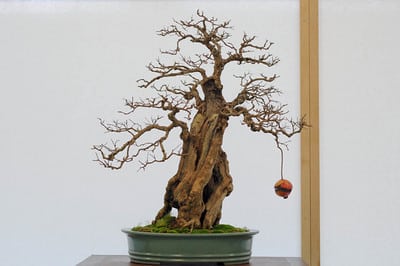
Pomegranate with fruit from last fall
My trident maple is beginning to suggest its eventual silhouette, but it has a long way to go. Daisaku Nomoto suggested that one could prepare any trident for Kokufu within three years. I knew tridents developed quickly, but three years? I asked how this was possible. “Easy,” he intoned. “Wire the tree and cutback three times each year and the tree will be ready.” Easier said than done, I’ve found. In the future, I’ll focus on developing the primary branch on the right hand side of the tree to improve its balance.
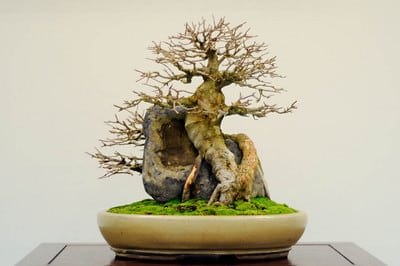
Root over rock trident maple
This gooseberry was one of the more fun deciduous trees in the exhibit. Nothing manicured about it – save the Bunzan pot.
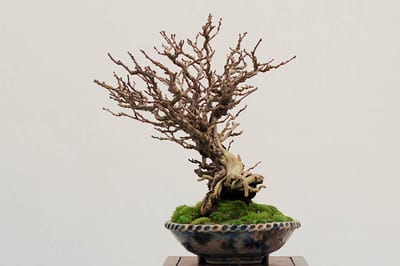
Gooseberry
The chojubai below was a perfect complement to the suiseki it accompanied (photos forthcoming).
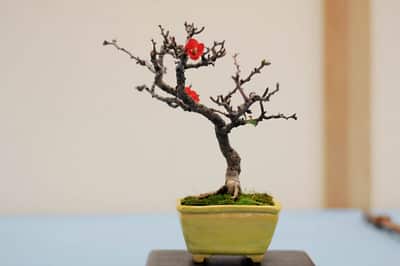
Flowering quince ‘chojubai’
We were fairly hard up for color at this year’s exhibit. The small pyracantha below did more than it’s fair share.
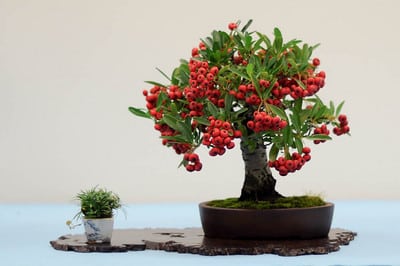
Pyracantha with mondo grass accent
Although typically grown for their flowers, azalea can also make great bonsai. Their trunks can show great age and their branches great development. The tree below, one of very few azaleas in this year’s exhibit, is off to a good start.
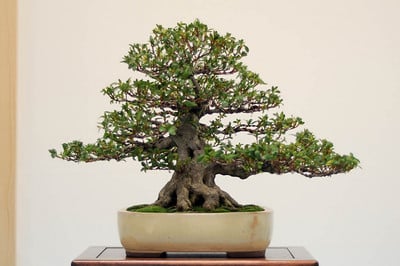
Satsuki azalea
Oaks, on the other hand, were very well represented this year. Oak, like redwood, is a popular variety for bonsai that you just don’t see very often in Japan. And although they grow in a variety of climates around the world, they are very evocative trees for Californians.
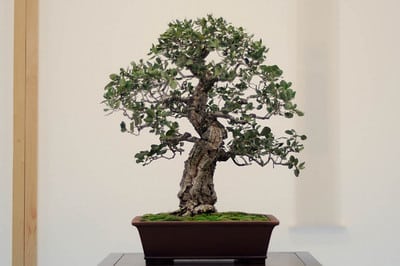
Cork oak
Here’s a question – is this a near-view or far-view bonsai? In other words, is the tree shown at “actual size” or does it evoke a much larger tree of similar proportions?
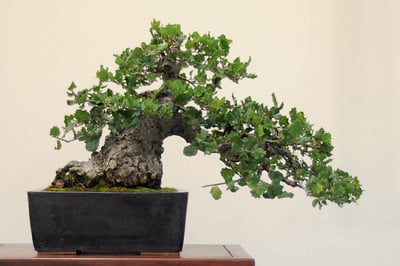
California live oak
Another question – why include broadleaf evergreens with the deciduous trees? For historical reasons. From what I’ve seen, many bonsai organizations in the US have greater success with coniferous trees than with deciduous. In Bay Island Bonsai, this bias is reflected in our judging as we have one category for conifers and another for deciduous and broadleaf trees.
Why coniferous collections are so commonly superior to deciduous collections is an interesting topic. To put it bluntly, I believe it’s harder to kill conifers than it is to kill deciduous trees. And it’s harder to ramify branches on deciduous trees than it is on conifers. Yes, there are many exceptions – and thank goodness! I very much appreciate deciduous trees and am working hard to improve my own. I’ve seen great improvement just in the past few years – a good sign that we’ll see more deciduous trees in future exhibits. A budding crop of newly minted bonsai experts returning from study in Japan will only fuel this trend.
Subscribe to Bonsai Tonight
New Posts Delivered Every Tuesday and Friday